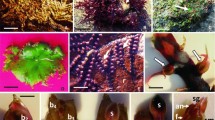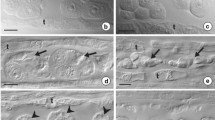Summary.
In this paper, the stages of normal sexual reproduction between pollen tube penetration of the archegonium and early embryo formation in Pinus tabulaeformis are described, emphasizing the transmission of parental cytoplasm, especially the DNA-containing organelles – plastids and mitochondria. The pollen tube growing in the nucellus contained an irregular tube nucleus followed by a pair of sperm cells. The tube cytoplasm contained abundant organelles, including starch-containing plastids and mitochondria. The two sperm cells differed in their volume of cytoplasm. The leading sperm, with more cytoplasm, contained abundant plastids and mitochondria, while the trailing one, with a thin layer of cytoplasm, had very few organelles. The mature egg cell contained a great number of mitochondria, whereas it lacked normal plastids. At fertilization, the pollen tube penetrated into the egg cell at the micropylar end and released all of its contents, including the two sperms. One of the sperm nuclei fused with the egg nucleus, whereas the other one was retained by the receptive vacuole. Very few plastids and mitochondria of male origin were observed around the fusing sperm and egg nuclei, while the retained sperm nucleus was surrounded by a large amount of male cytoplasm. The discharged tube cytoplasm occupied a large micropylar area in the egg cell. In the free nuclear proembryo, organelles of maternal and paternal origins intermingled in the neocytoplasm around the free nuclei. Most of the mitochondria had the same features as those of the egg cell, but some appeared to be from sperm cells and tube cytoplasm. Plastids were obviously of male origin, with an appearance similar to those of the sperm or tube cells. After cellularization of the proembryo, maternal mitochondria became more abundant than the paternal ones and the plastids enlarged and began to accumulate starch. The results reveal the cytological mechanism for paternal inheritance of plastids and biparental inheritance of mitochondria in Chinese pine.
Similar content being viewed by others
Author information
Authors and Affiliations
Corresponding author
Additional information
Correspondence and reprints: State Key Laboratory of Plant Physiology and Biochemistry, College of Biological Science, China Agricultural University, Beijing 100094, People’s Republic of China.
Rights and permissions
About this article
Cite this article
Guo, F., Hu, SY., Yuan, Z. et al. Paternal cytoplasmic transmission in Chinese pine (Pinus tabulaeformis). Protoplasma 225, 5–14 (2005). https://doi.org/10.1007/s00709-005-0088-4
Received:
Accepted:
Published:
Issue Date:
DOI: https://doi.org/10.1007/s00709-005-0088-4




